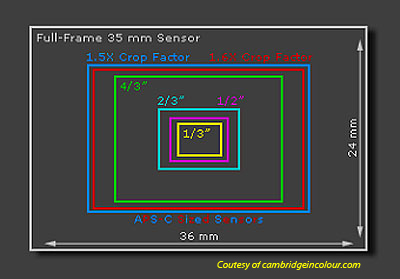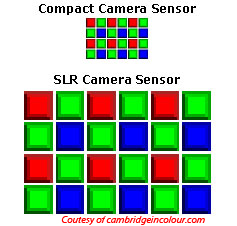The Digital Sensor: A Guide to Understanding Digital Cameras
by Wesley Fink on April 21, 2008 1:00 AM EST- Posted in
- Digital Camera
Sensors Today
| Sensor Size (mm) | ||
| Type | Width | Height |
| 1/3.6" | 4.00 | 3.00 |
| 1/3.2" | 4.54 | 3.42 |
| 1/3" | 4.80 | 3.60 |
| 1/2.7" | 5.37 | 4.03 |
| 1/2.5" | 5.76 | 4.29 |
| 1/2" | 6.40 | 4.80 |
| 1/1.8" | 7.18 | 5.32 |
| 1/1.7" | 7.60 | 5.70 |
| 2/3" | 8.80 | 6.60 |
| 1" | 12.80 | 9.60 |
| 4/3" | 18.00 | 13.50 |
| APS C | 23.70 | 15.70 |
| 35mm film | 36.00 | 24.00 |
In the above chart, the sensor sizes for today's DSLR cameras are in the range of 4/3" and APS C. A few top pro cameras now sport 35mm-size sensors and are referred to as full frame. Comparing this to Compact or Point and Shoot cameras today we generally find a 1/2.3" to 1/2.5" sensor. A few top-of-the-line compact cameras, like the Canon G9, feature a 1/1.8" to 1/1.7" sensor. To see the difference in the relative size of P&S sensors and DSLR sensors, look at the graphic below.

The very best compact cameras have sensors around the 1/3" to 1/2" range. The APS C to 4/3 sensors of the bulk of today's digital SLR cameras are huge by comparison. The developing push for full-frame at the top of the current DSLR market is a move to a sensor that is a bit more than double the size of today's APS C sensors. The approximate 24mm by 16mm APS C is the same size as the 1/2 frame 35mm championed by Olympus in the film era.
This size actually harkens back to 35mm motion picture film that became the standard on which most of the SLR lens systems are based. 35mm motion picture film contained images of around 24x16mm, and 35mm still film just turned the spool direction and used double the frame size. In fact, some early 35mm still cameras were referred to as "double-frame" cameras.
Why Does Sensor Size Matter?
In some of life's arenas bigger is better, but in computers and electronics we almost always see a trend toward smaller and smaller traces producing chips with higher and higher densities. So the question becomes why is a 10MP DSLR sensor any better than a 10MP Compact or Point and Shoot sensor?
The simple answer is that computer chips are digital devices, made up of transistors that register on and off (1 and 0) states, which are then combined to create the information we crunch in a computer. Digital sensors, on the other hand, are analog devices used to gather light and color information. Every digital camera then has some means to convert this analog sensor data to digital information in its processing path. Devices that communicate on and off do not require the sensitivity of devices that gather and convey more complex data like a digital sensor pixel.

Unlike digital data, all pixels are not created equal. Larger sensors, such as those used in digital SLR cameras, have larger pixels. All things being equal the larger pixels have more light-gathering ability over a given unit of time. This translates into two very important considerations for photography.
First, larger pixels exhibit lower noise than smaller pixels under the same conditions. This improved signal-to-noise ratio means that your 10MP DSLR image will likely produce better, sharper, clearer prints than the smaller 10MP compact (point and shoot) cameras. This improved SNR also means larger sensors produce a wider dynamic range (a greater range between the lightest and darkest elements of the photo).
The second aspect also relates to light gathering ability. Large DSLR sensors have more ability to gather light, which means they generally are more effective over a much wider range of lighting conditions than a compact camera. Many compact cameras are perfectly acceptable at ISO 100 but are very noisy by ISO 400. Most DSLR cameras with their larger sensors produce very acceptable results to ISO 800 or 1600 - ISO options not even available on most compact cameras. Some newer DSLR cameras even offer options of ISO 3200, ISO 6400, or even higher.










72 Comments
View All Comments
teng029 - Tuesday, April 22, 2008 - link
the rebel xti uses a cmos sensor.http://www.usa.canon.com/consumer/controller?act=M...">http://www.usa.canon.com/consumer/contr...&fca...
melgross - Monday, April 21, 2008 - link
Since when did the XTi use a CCD?